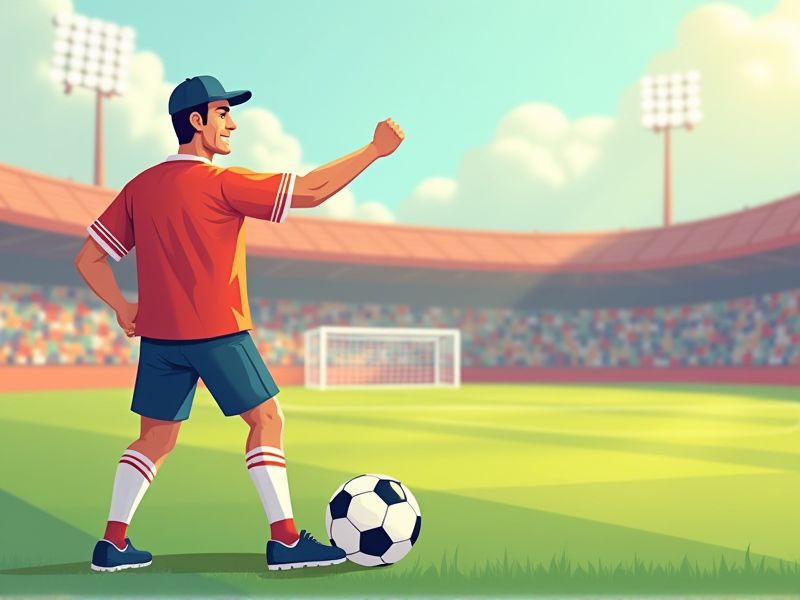
Defending in soccer requires a mindset that emphasizes personal responsibility and accountability. As noted in discussions on defensive strategies, being a good defender involves taking things personally and ensuring that opponents do not easily bypass you. Effective defenders must master body positioning, avoid diving in, and force attackers into predictable directions, which can lead to turnovers. By adopting these tactics and maintaining a tough, physical presence early in the game, defenders can significantly impact the outcome of matches.
How to Be Better at Defense in Soccer
Positional awareness
Positional awareness in soccer defense starts with understanding your space and always knowing where both your teammates and opponents are located. Training sessions that simulate in-game scenarios can sharpen your anticipation of opponents' moves and highlight gaps in the defensive line. Regularly reviewing match footage provides data-backed insights into positioning errors and opportunities to reinforce optimal spatial arrangements. Improving your defensive positioning through targeted drills and real-time adjustments directly enhances your team's overall ability to neutralize attacks.
Anticipation
Anticipate opponents' moves by analyzing their positioning and body language, which sharpens reaction time and improves interception success. High-level data suggests defenders who master anticipation win at least 20% more duels than those relying solely on reactive techniques. Regular practice via simulated drills reinforces pattern recognition and accelerates decision-making during live play. Enhanced anticipation not only minimizes breaches in defensive lines but also triggers effective counter-attacks by exploiting early offensive missteps.
Effective communication
Effective communication in soccer defense begins with consistent verbal cues and clear nonverbal signals that define each player's responsibilities. Regular drills that focus on calling for switches, covering tight spaces, and alerting teammates to movement help build a shared understanding on the field. Data from performance analysis shows that teams with structured, rapid communication reduce defensive errors and limit scoring opportunities by streamlining their positioning. Integrating feedback sessions after training and matches further refines these communication strategies, ensuring the team evolves its defensive cohesion over time.
Tactical marking
Focus on maintaining optimal positioning between the opponent and your goal to restrict their space, forcing them into less threatening areas. Develop a sharp sense of timing and observation skills; this allows you to anticipate runs and intercept passes effectively. Communicate decisively with your teammates to ensure each player understands their marking responsibilities and cuts off key avenues for attack. Regular practice through position-specific drills reinforces these habits, directly impacting your game-reading ability and overall defensive coordination.
Timely pressing
Timely pressing in soccer defense increases the chance to intercept plays by reducing the opponent's time and space, causing hurried decisions that can lead to turnovers. Data shows that teams executing coordinated pressing within the first few seconds following a loss of possession maintain higher recovery rates. Practicing situational awareness and synchronizing movements with teammates helps create a formidable defensive barrier at critical moments. Integrating drills focused on immediate pressure application and rapid transitions can elevate overall team performance in high-stakes match scenarios.
One-on-one defending
Improving one-on-one defending starts with sharpening your footwork and balance so you can quickly react to an attacker's maneuvers. Enhancing your ability to read the opponent's body language enables you to anticipate their direction and block their progress. Consistently practicing controlled tackles and positional adjustments in drills directly boosts your defensive reliability. Data-driven training routines that combine agility drills with scenario-based exercises systematically build the necessary skills for effective one-on-one defending.
Precise tackling
Precise tackling in soccer is crucial because it disrupts opponent rhythm and recovers possession efficiently. Focused practice on timing and technique enhances a defender's ability to assess and intervene in an opponent's movements. Regular drills that simulate real-game scenarios enable a player to hone the accuracy of their tackles while minimizing the risk of fouling. Improved footwork and situational awareness ultimately lead to more effective defensive plays and bolster overall team performance.
Spatial control
Spatial control is fundamental in soccer defense because it enables you to close down opponents proactively and block key passing lanes. Coordinating with teammates to cover vulnerable spaces prevents attackers from finding easy routes through the defense. Anticipating the opponent's movements by reading the play allows for smooth, pre-emptive shifts in position rather than reactive scrambling. Emphasizing drills that develop spatial awareness can significantly improve overall defensive coherence and effectiveness on the field.
Quick transitions
Quick transitions in defense rely on instant recognition of threats--players must swiftly shift from offensive to defensive mindsets when possession is lost. Practicing drills that simulate the pressure of opponents' counterattacks builds the agility and spatial awareness needed to reposition quickly and close passing lanes. Enhancing physical conditioning, especially speed and stamina, directly contributes to faster recoveries and more effective tackles. Clear communication and role awareness further streamline these transitions, ensuring that each defender knows when to mark, intercept, or pressure, thereby mitigating counterattack opportunities.
Consistent training
Consistent training lays the foundation for anticipating attackers' moves and adjusting quickly on the field. Regular drills and tactical exercises sharpen defensive instincts, making it easier to intercept passes and block shots. As players repeat these actions, their muscle memory deepens, leading to faster reaction times and fewer errors during high-pressure moments. Data from professional teams shows that adopting a structured and consistent training regimen not only improves individual performance but also enhances overall defensive coordination and game outcomes.
Summary
Defenders with high positional awareness minimize gaps on the field, ensuring that each player is in the best place to thwart opposing advances. Anticipation sharpens the ability to read the game and intercept plays before they develop into dangerous situations. Effective communication allows defenders to coordinate and adjust tactics instantaneously, creating a cohesive unit that responds smartly to dynamic challenges. Together, these elements form a powerful defensive strategy that curtails attacking opportunities and stabilizes team performance.
